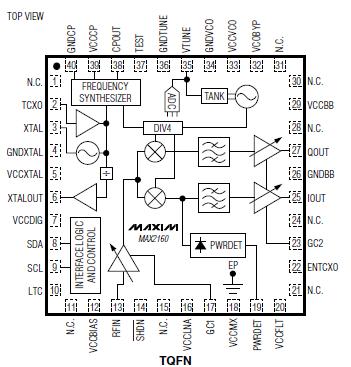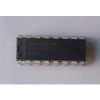Features: ·Low Noise Figure: < 4dB Typical
·High Dynamic Range: -98dBm to 0dBm
·High-Side or Low-Side LO Injection
·Integrated VCO and Tank Circuits
·Low LO Phase Noise: Typical -88dBc/Hz at 10kHz
·Integrated Frequency Synthesizer
·Integrated Bandpass Filters
·52dB Typical Image Rejection
·Single +2.7V to +3.3V Supply Voltage
·Three Low-Power Modes
·Two-Wire, I2C*-Compatible Serial Control Interface
·Very Small Lead-Free WLP PackageApplication·Cell Phone Mobile TVs
·Personal Digital Assistants (PDAs)
·Pocket TVsPinout Specifications
SpecificationsAll VCC_ Pins to GND............................................-0.3V to +3.6V
All Other Pins to GND.................................-0.3V to (VCC + 0.3V)
RFIN, Maximum RF Input Power ....................................+10dBm
ESD Rating ...........................................................................1kV
Short-Circuit Duration
IOUT, QOUT, CPOUT, XTALOUT, PWRDET, SDA,
TEST, LTC, VCOBYP ..............................................................10s
Continuous Power Dissipation (TA = +70°C)
40-Pin Thin QFN (derate 35.7mW/°C above +70°C)...2857mW
WLP (derate 10.8mW/°C above +70°C).......................704mW
Operating Temperature Range .......................-40°C to +85°C
Junction Temperature....................................................+150°C
Storage Temperature Range .........................-65°C to +150°C
Lead Temperature (soldering, 10s) ...............................+300°C
Stresses beyond those listed under "Absolute Maximum Ratings" may cause permanent damage to the device. These are stress ratings only, and functional operation of the device at these or any other conditions beyond those indicated in the operational sections of the specifications is not implied. Exposure to absolute maximum rating conditions for extended periods may affect device reliability.
DescriptionThe MAX2160/EBG tuner ICs are designed for use in Japanese mobile digital TV (ISDB-T single-segment) applications. The devices directly convert UHF band signals to a low-IF using a broadband I/Q downconverter. The operating frequency range extends from 470MHz to 770MHz.
The MAX2160/EBG support both I/Q low-IF interfaces as well as single low-IF interfaces, making the devices universal tuners for various digital demodulator IC implementations.
The MAX2160/EBG include an LNA, RF variable-gain amplifiers, I and Q downconverting mixers, low-IF variablegain amplifiers, and bandpass filters providing in excess of 42dB of image rejection. The parts are capable of operating with either high-side or low-side local oscillator (LO) injection.
The MAX2160/EBG's variable-gain amplifiers provide in excess of 100dB of gain-control range. The MAX2160/EBG also include fully monolithic VCOs and tank circuits, as well as a complete frequency synthesizer. The devices include a XTAL oscillator as well as a separate TCXO input buffer. The devices operate with XTAL/TCXO oscillators from 13MHz to 26MHz allowing the shared use of a VC-TCXO in cellular handset applications. Additionally, a divider is provided for the XTAL/TCXO oscillator allowing for simple and lowcost interfacing to various channel decoders.
The MAX2160/EBG are specified for operation from -40°C to +85°C and available in a 40-pin thin QFN leadfree plastic package with exposed paddle (EP), and in a lead-free wafer-level package (WLP).

 MAX2160 Data Sheet
MAX2160 Data Sheet







